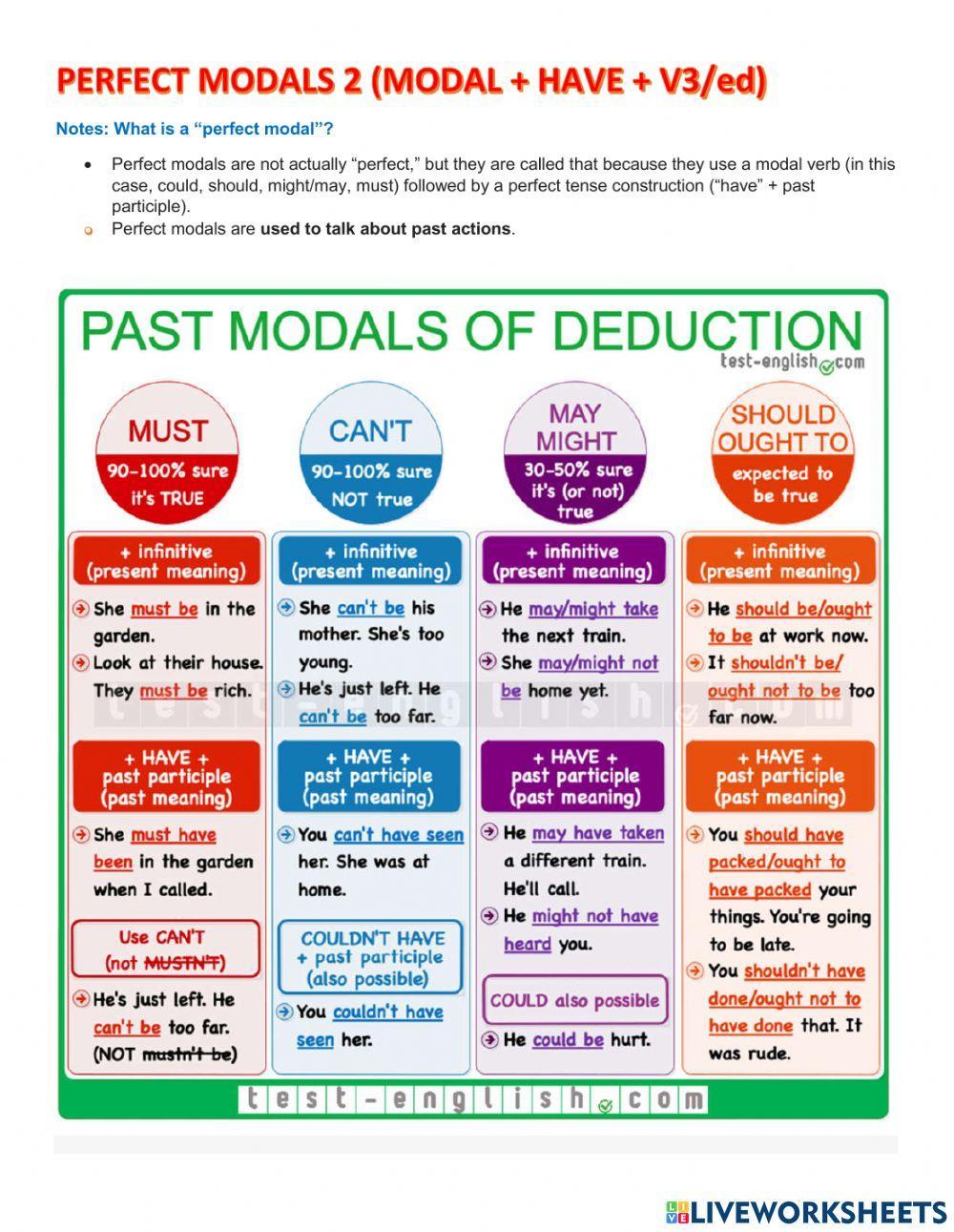Member for
4 years 4 monthsAge: 10+
Level: INTERMEDIATE, IELTS
Language: English
(en)
ID: 1524458
14/10/2021
Country code: VN
Country: Vietnam
Main content: Modals, modal perfect (1574335)
From worksheet author:
WE CAN USE PERFECT MODALS TO EXPRESS SUCH MEANINGS AS PAST DEDUCTION OR CRITICISM.
Other contents:
MUST HAVE DONE, CAN'T/ COULDN'T HAVE DONE, SHOULD/SHOULDN'T HAVE DONE, MAY/MIGHT/COULD HAVE DONE, OUGHT TO HAVE DONE
Worksheet description:
Educational Objective:
This worksheet aims to reinforce students' understanding of perfect modals in English, specifically focusing on the combination of modal verbs with "have" and the past participle. By the end of the activity, students should be able to accurately use perfect modals to discuss past actions and make deductions about situations.
Content Overview:
The main content of this worksheet centers around perfect modals, exploring how modal verbs like could, should, might/may, and must can be combined with "have" and the past participle to form sentences about past events. Students will practice identifying and constructing sentences using perfect modals to express past actions and deductions.
Language and Educational Level Context:
Designed for students studying English as a Foreign Language (EFL) or English as a Second Language (ESL), this worksheet caters to learners at an intermediate level. The exercises are structured to provide a challenge while also offering support for students to grasp the concept of perfect modals and apply them correctly in context.
Subject Relevance:
Situated within the EFL and ESL domains, this worksheet connects students to essential grammar rules and language structures that are vital for effective communication in English. By focusing on perfect modals, students can enhance their language skills and confidently express past actions and deductions, aligning with the broader curriculum goals of language proficiency and fluency.
Instructions:
The instructions for this worksheet guide students through the concept of perfect modals, clarifying that they are named as such due to the combination of modal verbs with "have" and the past participle. By introducing modal verbs like could, should, might/may, and must in conjunction with the perfect tense construction, students can understand how perfect modals are utilized to describe past actions accurately. The inclusion of examples like "She must be in the garden" underscores the application of the concept, allowing students to practice forming sentences and making deductions using must and other modal verbs. Through these structured instructions, students can engage with the material effectively and deepen their understanding of perfect modals in English.
This worksheet aims to reinforce students' understanding of perfect modals in English, specifically focusing on the combination of modal verbs with "have" and the past participle. By the end of the activity, students should be able to accurately use perfect modals to discuss past actions and make deductions about situations.
Content Overview:
The main content of this worksheet centers around perfect modals, exploring how modal verbs like could, should, might/may, and must can be combined with "have" and the past participle to form sentences about past events. Students will practice identifying and constructing sentences using perfect modals to express past actions and deductions.
Language and Educational Level Context:
Designed for students studying English as a Foreign Language (EFL) or English as a Second Language (ESL), this worksheet caters to learners at an intermediate level. The exercises are structured to provide a challenge while also offering support for students to grasp the concept of perfect modals and apply them correctly in context.
Subject Relevance:
Situated within the EFL and ESL domains, this worksheet connects students to essential grammar rules and language structures that are vital for effective communication in English. By focusing on perfect modals, students can enhance their language skills and confidently express past actions and deductions, aligning with the broader curriculum goals of language proficiency and fluency.
Instructions:
The instructions for this worksheet guide students through the concept of perfect modals, clarifying that they are named as such due to the combination of modal verbs with "have" and the past participle. By introducing modal verbs like could, should, might/may, and must in conjunction with the perfect tense construction, students can understand how perfect modals are utilized to describe past actions accurately. The inclusion of examples like "She must be in the garden" underscores the application of the concept, allowing students to practice forming sentences and making deductions using must and other modal verbs. Through these structured instructions, students can engage with the material effectively and deepen their understanding of perfect modals in English.
Share / Print Worksheet

